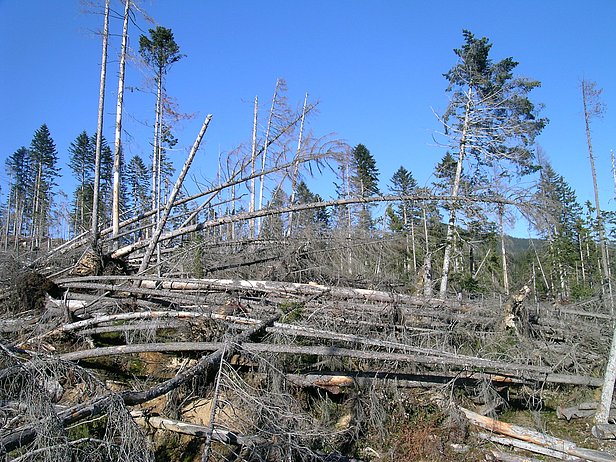With climate change, violent storms that can destroy forests over large areas are becoming more frequent. We are investigating what this means for forest services and how forests regenerate. From the lessons of storms Vivian (1990) and Lothar (1999), we have developed decision support tools for forest operations.
Contents ¶
Storms become more frequent ¶
It is as if the devastating winter storms Vivan (1990) and Lothar (1999) had been harbingers: Number and severity of storms have increased significantly in Switzerland over the past 50 years, causing enormous damage to Swiss forests (see graphs). Increasing heat weakens trees and makes them more susceptible to storm damage. In protection forests, which include two-thirds of Swiss forests, protection against natural hazards is declining.
For forest enterprises, windthrown timber is an enormous burden, as they are forced to carry out unplanned timber clearances while prices are dropping at the same time. The removal of trees is time-consuming and expensive, especially in the mountains. Therefore, we are investigating whether dead, lying trees can still provide forest services such as avalanche or rockfall protection. We also examine the effects of bark beetle damage that occurs as a result of windthrow disturbances.
In the aftermath of such events, we monitor how forest ecosystems develop, for example the amount of young forest regrowth or the loss of humus and soil in mountain forests. We summarize our findings in scientific publications as well as in recommendations for forest management.
Lessons from Vivian and Lothar ¶
Together with the Federal Office for the Environment FOEN and numerous partner institutions, we have intensively studied the consequences of storms Vivian and Lothar and published numerous decision-making aids. A summary can be found in the special issue of the Swiss Journal of Forestry SZF 03/2015 (free access). Forestry and research have learned their lessons from the management of storm areas, especially in protection forests, and thanks to them are better prepared for similar events in the future.

